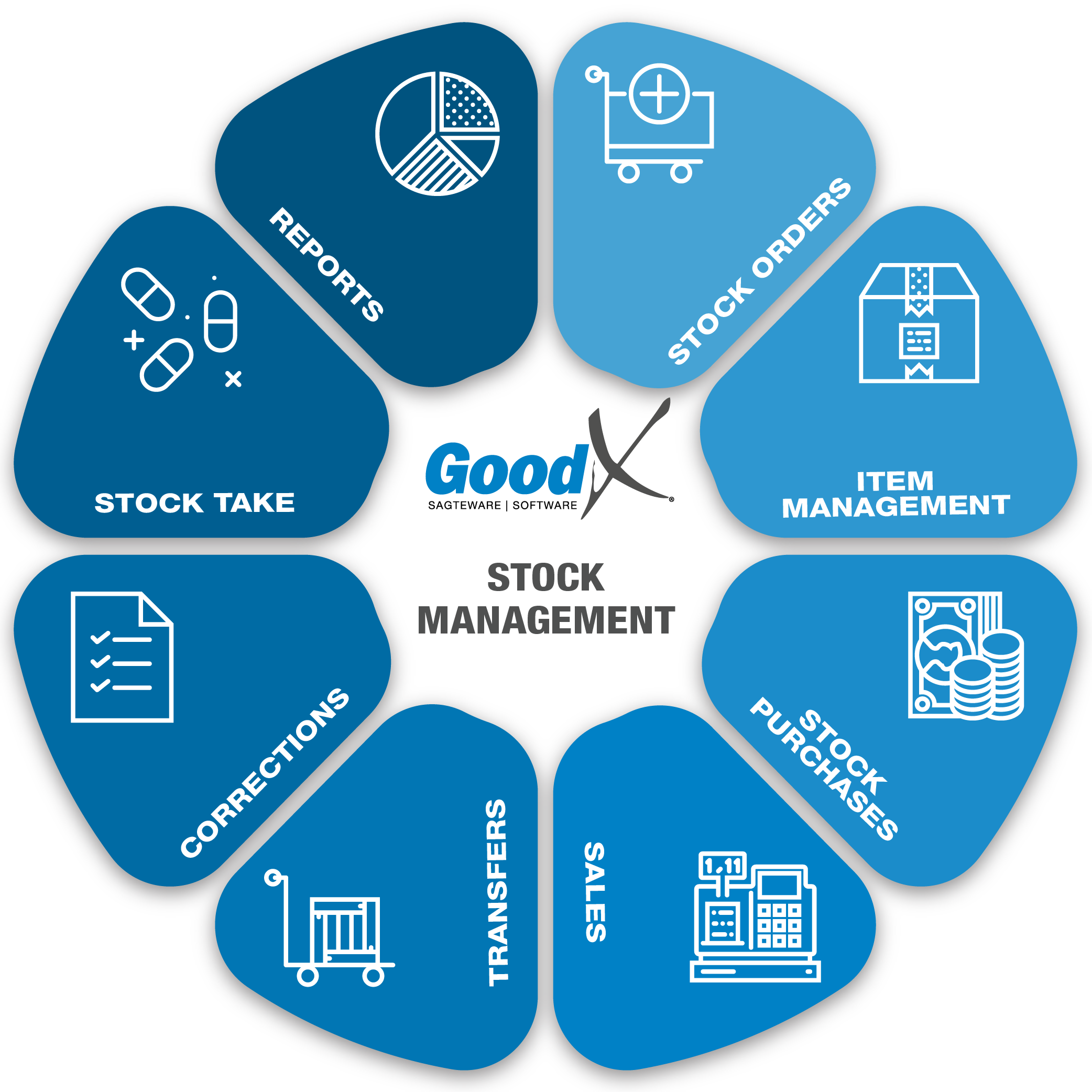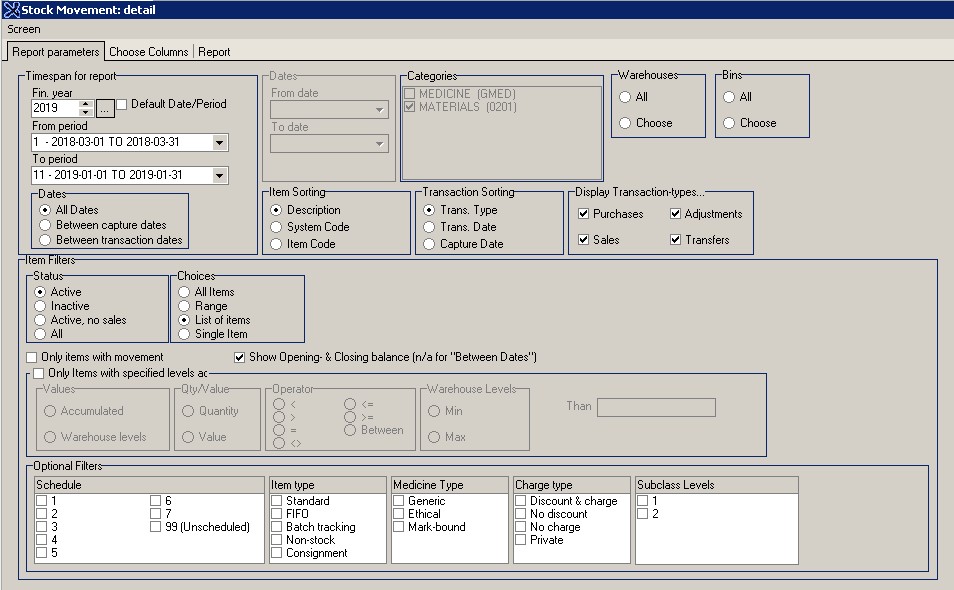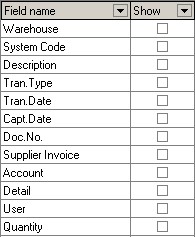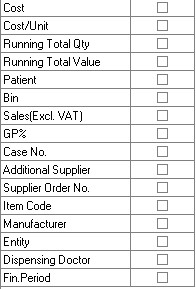Best Practice Guidelines: Stock Management

Copyright © 2020 GoodX Software. All rights reserved.
GoodX online Learning Centre
learning.goodx.co.za
10. Reports
10.2. Stock Movement per Detail

The Stock movement detail report will be used to see the complete Audit trail of the stock items. The Movement report can be drawn per single item, per a list of items or for all the items that have movement.
The Movement report can be set up in different columns according to the practice's needs.
If there are descriptions on the reports please refer back to the glossary for the explanation if not mentioned in the Guideline booklet.
The following detail will display on the report for each item depending on the report setup:
- Opening balance for the financial period, transaction date or capture date
- Closing balance for the financial period, transaction date or capture date
- System and Item code
- Type of transaction
- Document number (Invoice number - auto-generate from GoodX)
- Item description
- Transaction date
- Capture date
- Cost per units
- Running total quantity
- Running total value
- Case number applicable to Hospitals, Clinics and Day Clinics
- Financial Entity
- Bin where the movement took place
- Financial period
Purchases:
- Supplier who the item was purchased from
- Supplier invoice number
- Creditor or Supplier account number
- The user who captured the Purchase / Supplier invoice
- Total Quantity that was bought
- The total amount of stock items purchased for VAT excl.
- Additional Supplier (Applicable when Hospiformance or CJ Distributions are used for the purchases)
- Supplier order number
- Manufacturer of the Item
Sales:
- Patient Name and Surname
- Debtor account number
- Debtor Name and Surname
- The user who did the billing on the patient account
- The quantity that was given to the patient and billed on the patient account
- Item Cost of sales amount
- The amount of the stock items was sold to the patient excl VAT
- Dispensing Doctor
- GP%
Transfers:
- Transfer Code
- Transfer Description
- The user who did the transfer
- The quantity that was transferred from or to the specified warehouse (Negative quantities indicate that stock was transferred from the warehouse, Positive quantities indicate that stock was transferred to the warehouse)
- The value of the total qty transferred
- The Unit value of the item transferred
Adjustments:
- Type of stock adjustment (Code and Description)
- Ledger account
- The user who did the stock adjustment
- The quantity that was adjusted (Adjustment with a negative (-) to make the stock less and a positive (+) to make the quantity more)
- The value that was adjusted
EXAMPLE OF A MOVEMENT REPORT WITH THE DIFFERENT TRANSACTIONS


Stock Movement per Detail report setup and explanations
Report Parameters

1. Dates on "All Dates" - Timespan for the report
- Fin. year - The Financial year the information will be based on
- ... button - Default date controls to the current date (From and to periods)
- Tick box Default Date/Period - Will always use the current date and period when the report is drawn
- From period - The financial period where the movement must start from (must include from)
- To period - The financial period where the movement must end (must include still)
2. Dates on "Between capture dates" and "Between transaction dates" - Dates from and to (Timespan for the Report will be greyed out and the Dates field will be editable)

- From date - from the day the transactions must start and be included
- To date - when the last day must be and be included
- Capture dates - When the transaction was captured on the system
- Transaction dates - When the transaction took place
3. Categories
- Categories - There are different categories of stock depending on the speciality of the Company or Practice
- A Medical Practices stock will be divided into 2 Categories - Medicine and Materials
- Medicine (GMED) - All the medicine will fall under this category
- Material (0201) - All the consumables and injectables will fall under this category
- Hospital stock (GMED) - The Hospitals will only have one Category with all the items under one category
- There can be more categories depending on the Practice, for example, Stationary, Groceries, Front Shop, etc.
4. Warehouses
- This setting is only applicable for practice with a multiple warehouse setup
- All - Transactions will be grouped per Warehouse
- Choose - The Warehouse can be chosen to see the transactions inside that Warehouse or Multiple Warehouses
5. Item Sorting
- Item sorting is done according to the different items that are included in the report
- The sorting of the information in the report can be according to Description, System Code or Item Code
- The sorting can also be adjusted in the report with the filters on the columns
6. Transaction Sorting
- Transaction sorting is done on the detail
- The transaction can be sorted according to Transaction Type, Capture Date or Transaction Date
- The sorting can also be adjusted in the report with the filters on the columns
7. Display Transaction Types
- The transaction types should be included in the movement report
- Purchases - All the stock that was bought (purchased) from the Suppliers, and Credit notes done on the Suppliers
- Sales - All stock that was sold to the patients or used on the patients and the Credit notes that were processed on the Debtors accounts
- Adjustments - All the adjustments that were done on the items, Broken stock, expired stock, Lost stock and Stock Takes
- Transfers - All the transfers that were done between the Warehouses, moved from one Warehouse to another.
8. Item Filters: Status
- Filters on the items, only this information will be available, unique indicators on the items
- Active items - Only the Active items and not the Inactive items
- Inactive Items - Only the Inactive items and not the items that are active
- Active, no sale - Only the items that are marked as Active, no sale
- All items - This will include all the items on the list, Active, Inactive and Active, no sale
9. Item Filters: Choices
- All Items - Will include all the items that have the markers indicated on the report setup
- A range of Items - All items from a number to a number, for example from Item code GMED20 till item code GMED29, all the items between these numbers will be included with the markers that were set up.
- List of items - Will give the choice to indicate a list of items, the list can be imported from a notepad or typed into the list function
- Single item - Only one item that must be chosen will display with the markers as set up on the report
10. Only items with movement
- Only the items that have transactions on between the dates of the report settings will be displayed on the report.
11. Show opening and closing balances
- Will show the opening and the closing balance of the items for the period that was chosen.
- This function is not available for between transaction or capture dates.
- Opening balance is the value and quantity of the previous period closing balance.
- Closing balance is the value and quantity at the end of the current period and will be the opening balance for the next period.
12. Only items with specified levels: Values
- Warehouse levels: This option will be available to choose which quantity the items must have before displaying the items in that warehouse.
13. Only items with specified levels: Qty/Value
- Quantity: Specified level on the total quantity of the stock items
- Value: Specified total rand value of the stock items
14. Only items with specified levels: Operator
- > Bigger than
- < Smaller than
- = equals
- <> smaller or bigger but not equal
- >= Bigger and equal than
- <= Smaller and equal than
- Between - between two values
- The system will ask the quantity or value where this should be applicable to
15. Only items with specified levels: Warehouse Levels
- Min - Minimum quantity stock levels
- Max - Maximum quantity stock levels
- The system will ask what the min or max levels need to be included in the report
16. Optional Filters: Schedule
- 1 till 7 - The items are classified with a schedule according to the Health Council
- 99 is unscheduled stock items, normally non-stock and some consumables.
- A register must be kept on Schedule 5, 6 and 7.
- Multiple schedules can be chosen
- If none is chosen all the schedules will be included in the report
17. Optional Filters: Item Type
- The item is classified with the type, please refer to the Glossary for the explanations on the terms of the stock types.
- The Stock types can be chosen for one or multiple types that need to be included in the report
- If none is ticked all the types will be displayed in the report
- Different types are Standard, FIFO, Batch tracking, Non-Stock and Consignment
18. Optional Filters: Medicine Type
- The Medicine type will not be applicable, this filter will be taken out in the future.
19. Optional Filters: Charge type
- The Charge type will apply certain rules on the item when it comes to billing and capturing the purchases.
- Please refer to the Glossary for more explanation on the different Charge types.
- The different Charge types are Discounted & Charge, No discount, No Charge and Private.
20. Optional Filters: Subclass Levels
- The different subclass levels that are linked to the item.
- The report can be drawn on one or multiple subclasses if the practice is using subclasses.
- If none is ticked the system will not indicate the subclass.
Report Columns
Different columns can be ticked to show the different information. This will assist to show only the information the practice needs for the specific purpose.
When a report has too much information on it, it is not easy to understand. If the report does not have enough information, the report is worthless.


Functions that will be used in GoodX
- Stock Movement: Detail (Reports > Stock Movement: Detail > Choose profile or Edit the blank profile to choose your own settings)